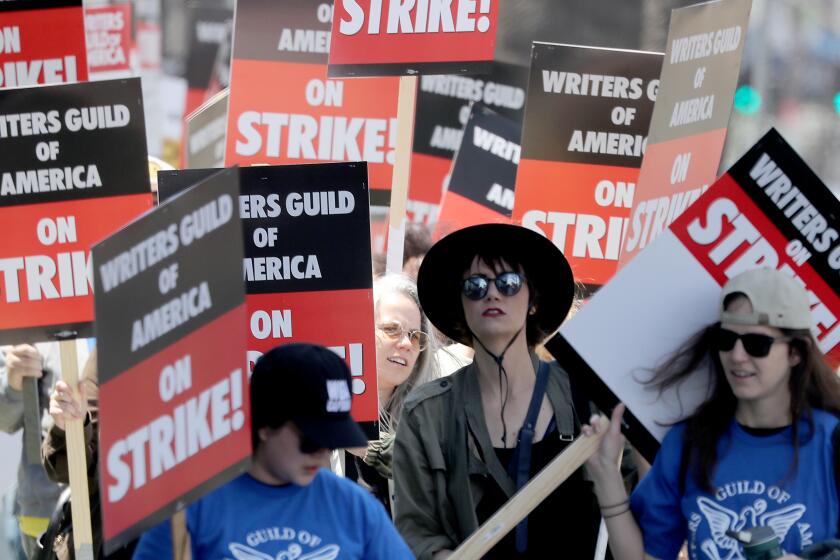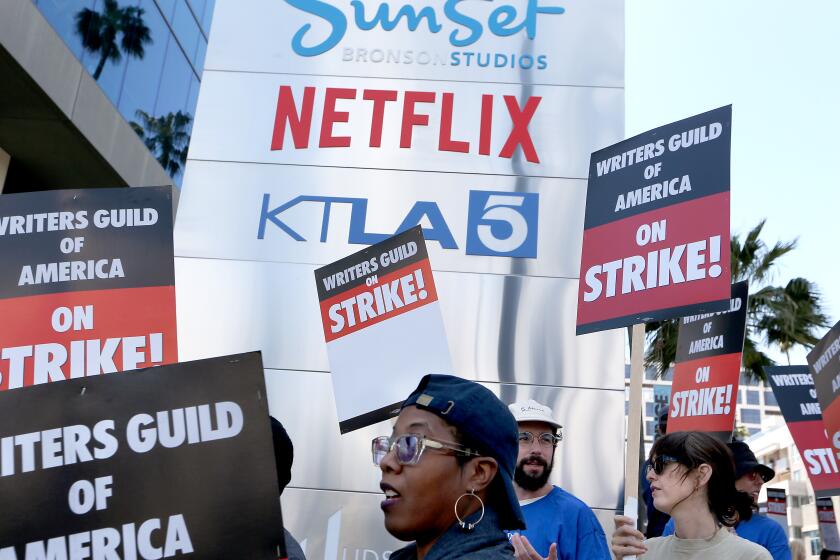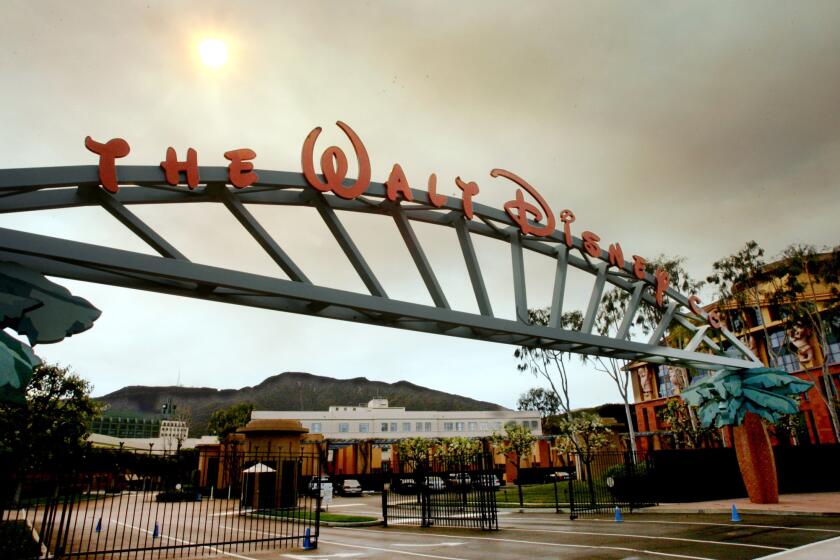Why the war over streaming data is at the heart of Hollywood’s strikes

- Share via
Years ago, at the beginning of the streaming wars, writers like “One Day at a Time” reboot co-showrunner Gloria Calderón Kellett called Netflix a “black hole” because, unlike with broadcast TV, she didn’t know how many people were watching the show.
Rivals such as Apple TV+, Amazon Prime Video, Disney+ and Paramount+ adopted a similarly opaque approach to viewership, rarely revealing exactly how large a show’s audience was.
For writers, it was a trade-off: On one hand, some creators liked not being held to the standard of daily Nielsen ratings. On the other, data for a hit series can be helpful leverage in negotiating future deals.
Now the battle for transparency in streaming data has become one of the biggest dividing lines in the ongoing actors’ and writers’ strikes, dual work stoppages that Hollywood hasn’t seen since the 1960s. Performers union SAG-AFTRA and the Writers Guild of America say video streaming services have benefited from the work of their members, and they want film and TV writers and actors to be rewarded when they make a hit.

Subscribers get exclusive access to this story
We’re offering L.A. Times subscribers special access to our best journalism. Thank you for your support.
Explore more Subscriber Exclusive content.
To achieve that goal, actors and writers say, they need to know how many people are watching.
The 2023 writers’ strike is over after the Writers Guild of America and the Alliance of Motion Picture and Television Producers reached a deal.
The issue has created a pickle for streamers that are part of the Alliance of Motion Picture and Television Producers, which negotiates on behalf of the major entertainment companies, including Netflix.
Inside the business of entertainment
The Wide Shot brings you news, analysis and insights on everything from streaming wars to production — and what it all means for the future.
You may occasionally receive promotional content from the Los Angeles Times.
During a meeting with fellow studio CEOs earlier this summer, Netflix co-Chief Executive Ted Sarandos pushed his counterparts to move the talks along with major concessions and at one point suggested that Netflix could splinter off but wanted to work with the AMPTP, according to a person close to the negotiations who was not authorized to comment.
However, Netflix and other streaming services haven’t been willing to give writers access to data in a way that would satisfy the WGA’s demands, according to two other people close to the negotiations. Still others credited Netflix, the largest subscription streaming platform, for being more open with data than its rivals, albeit not as much as the guild would like.
Netflix declined to comment. The AMPTP has disputed suggestions of fracturing within its ranks.
The labor dispute speaks to the long-standing distrust between writers and studios, who have engaged in legal battles over how much talent should earn from popular shows like “The Walking Dead,” even when those shows do have reliable viewership data. But defining what success is on a streaming service can be difficult because each relies on different metrics. What matters to Netflix — whose business is primarily subscriptions — is different from Apple, whose main business is selling iPhones, not its streaming service.
“There’s so many different ways to measure success, so you need to get as much data as possible to be able to organize your thinking about what really defines success,” said Jeremy Zimmer, CEO of Beverly Hills-based United Talent Agency. “If one group is staring at a set of figures and they’re negotiating with another group who doesn’t have any numbers, it makes it a very one-sided conversation.”
How platforms like Netflix and Prime Video measure success can mean the difference between life and death for a show. But those metrics remain opaque.
As a compromise, the AMPTP — which represents Netflix, Disney, Paramount, Apple, Amazon, NBCUniversal and Warner Bros. Discovery — offered to give the WGA confidential quarterly reports that show total minutes viewed of high-budget films and series and the programs’ total running time. The AMPTP described its proposal as “unprecedented data transparency.”
“This increased transparency will enable the WGA to develop proposals to restructure the current SVOD (subscription video on demand) residual regime in the future,” the AMPTP said in a statement.
Sign up for This Evening's Big Stories
Catch up on the day with the 7 biggest L.A. Times stories in your inbox every weekday evening.
You may occasionally receive promotional content from the Los Angeles Times.
But the WGA said there were shortcomings in the alliance’s pitch. Although the AMPTP would allow six guild staff members to study the data, “No writer can be told by the WGA about how well their project is doing, much less receive a residual based on that data,” the WGA’s negotiating committee wrote in an Aug. 24 note to the union’s members.
“The counteroffer is neither nothing, nor nearly enough,” the negotiating committee said in its memo.
Amid a dearth of fresh content during the Hollywood strikes, consumers are rediscovering older series and movies to keep themselves entertained.
Striking actors and writers — many of whom gathered for a SAG-AFTRA solidarity rally Wednesday starting outside Netflix’s Los Angeles offices — have been vocal in demanding more data, and better compensation to go along with it. Shows such as “Breaking Bad” and “Suits” have become hits on Netflix after their run on traditional television channels, and performers and scribes want to be financially rewarded when their programs blow up.
“It would be better if we got paid more money when our viewership numbers went up,” Aaron Korsh, creator of law drama “Suits,” told The Times last month. “I do think it is reasonable and achievable to expect residuals to go up, commensurate with increased views.”
Why many members of the Writers Guild of America have targeted streaming giant Netflix in their fight for higher streaming residuals.
For years, streamers have been reluctant to share more data with the public. If they did, they would reveal not only which shows were big successes but also the ones that were costly flops.
Nonetheless, over time, streamers have shared more of their data privately with talent. On an episode of “The Breakfast Club” radio program, producer Charles D. King praised Netflix for providing data on his firm’s titles, adding that he hopes platforms deliver more transparency along with ways to reward creators for their wins.
Netflix publishes a weekly top-10 website, which breaks down viewership rankings for movies and shows globally and by country. But it only covers the most popular programs. Still, the data is more than that provided by competitors.
Streamers like Disney+ will selectively release figures, such as “Star Wars” show “Ahsoka” getting 14 million views for its debut episode in its first week and becoming the platform’s most-viewed series — but there’s no context for how that measures up with shows on other services.
Third-party analytics firms also have gotten in the mix. TV ratings giant Nielsen compiles a weekly top-10 list of streaming shows.
Some talent representatives complain there isn’t enough data to contextualize what the performance means. However, executives from smaller streaming companies say that providing comprehensive data for the whole industry — the way Nielsen does with TV and Comscore does for the box office — would make for apples-to-oranges comparisons.
The threshold for a hit on Netflix, which has more than 238 million global subscribers, is different from that of Peacock, Paramount+ or Max, which have smaller audiences.
Union reps point out that Netflix has existing agreements abroad that give additional payments to creatives for successful programs. In Germany, talent are financially rewarded if their Netflix film surpasses a certain number of subscribers who watch at least 90% of its runtime. A similar agreement was reached for original TV series.
Budgets on European shows tend to be lower, with smaller upfront payments compared with those to artists in the U.S. Nevertheless, the arrangements show that it’s possible to share program completion data with unions, guild members say.
“You can see this battle being fought in a number of different places,” said Laura Blum-Smith, director of research and policy for WGA West. “When the companies act like, ‘Oh, no, we could never possibly disclose this,’ I think that’s just disingenuous.”
A decade after Netflix disrupted the industry with ‘House of Cards,’ Peak TV is in retreat, and in its place is a new era of discontent.
SAG-AFTRA, in its proposal to the studios, offered a workaround in which performers would share in the revenue generated from their shows on streaming services using data from Parrot Analytics, which looks at consumer behavior to determine how much “demand” exists for a given title.
“We have this technology that captures this behavior, and this behavior is a good indicator of financial performance,” said Alejandro Rojas, Parrot Analytics’ vice president of applied analytics.
But the AMPTP raised concerns about the proposal, voicing doubts about whether Parrot’s data showed a “demonstrable link to the actual revenue received by the service in the form of new or retained subscribers.” Parrot bases its calculations on consumption through peer-to-peer services, social video, social media chatter and other metrics.
Providing a residual based on viewership comes with its own complications. In typical streaming deals, companies pay higher fees upfront, effectively buying out what would have been the artists’ profit participation.
A new deal structure could have a significant impact on the long-term earnings of show creators.
“Under the current streaming model, talent does better, almost all of the time, through increased fees, plus some kind of buyout, for any show that is a failure or is a middling or partial success,” said Simon Pulman, a partner and co-chair of the entertainment practice at Pryor Cashman LLP. “Where talent doesn’t do better is when you have a home run — a ‘Seinfeld’ or ‘The Walking Dead.’”
Critics of the unions’ proposals say the guilds want to have their cake and eat it too.
Negotiations between AMPTP and WGA restarted last month, but there has not been much movement since then.
The AMPTP has argued that the actors’ proposal in particular is seeking rewards in the event of success without any additional risk from the performers, whereas the studios are taking big financial swings on high-budget productions that may not make any money.
SAG-AFTRA chief negotiator Duncan Crabtree-Ireland disagreed. “Actors put a lot more risk into these projects than the executives who sit back and collect huge bonuses when these projects are successful,” he said.
Times staff writers Meg James and Ryan Faughnder contributed to this report.
More to Read
Sign up for This Evening's Big Stories
Catch up on the day with the 7 biggest L.A. Times stories in your inbox every weekday evening.
You may occasionally receive promotional content from the Los Angeles Times.


















